Twin Blast That Ripples the Tranquillity of Temple Town: An Autopsy as Well as Sem-Eds Based Study of Post Blast Residues
Manoj Kumar Pathak*, Shashank Shekhar Jha, Satish Kumar Khalkho, Nishant Purbey and Utkarsh Tiwari
Department of Forensic Medicine, Institute of Medical Sciences, India
Submission: December 08, 2018;December 10, 2018; Published: January 24, 2019
*Corresponding author:Manoj Kumar Pathak, Department of Forensic Medicine, Institute of Medical Sciences, India
How to cite this article: Manoj K P, Shashank S J, Satish K K, Nishant P, Utkarsh T. Twin Blast That Ripples the Tranquillity of Temple Town: An Autopsy 002 as Well as Sem-Eds Based Study of Post Blast Residues. J Forensic Sci & Criminal Inves 2019; 11(3): 555811. DOI: 10.19080/JFSCI.2018.11.555811.
Abstract
Introduction India had the highest number of bomb blasts in the world in the past 2 years, according to the National Bomb Data Centre (NBDC). Among the most difficult kind of crimes to solve today are those that involve the use of explosives. The post-blast analysis of trace amounts of explosives is particularly difficult because traces are usually trapped in or deposited on various debris materials. Material and methods Details of the post-mortem findings of these two blast cases, father and son duo, aged 50 years and 19 years respectively, were painstakingly explored at autopsy room of Department of Forensic Medicine, Institute of Medical Sciences, B.H.U., Varanasi on August 29th, 2018. Result Nasal bleeding from external nasal orifices was present indicating fracture of base of skull (anterior cranial fossa). These were instantaneous deaths due to blast effect on back of the head. The post blast residue particles collected from the scene of crime and from the body during post-mortem examination as well as clothes of the victims, showed white crystalline powder which was soluble in water, were detected. Conclusion The post-mortem examination is critical to the investigation of explosives related deaths for all these purposes, the ability to discriminate between the explosive charges fired based solely on the remaining residues has invaluable potential at post-blast crime scenes where the rapid nature of investigations requires fast results.
Keywords: SEM-EDX/EDS; IED; NBDC; ANFOAL; Blast lung; Peppering
Background
A 50-year-old man and his son were killed in an explosion in a Varanasi village Wednesday 29-08-2018. The incident took place in Milkipur village under Chaubeypur police station of Varanasi district, UP, India in the early hours. The deceased used to run a fodder shop on the ground floor of their house for the last two decades. The killed old man and his nephew 12 years old boy, who was sleeping on another cot a few metres away, claimed that he did not hear anything and came to know about the killing incident only in the morning. Police suspected that bombs placed under their cots exploded while they were asleep. Later in the course of investigation, it was revealed that the accused had motive for this homicide and that was a meagre 10 feet disputed land between the accused and the deceased
Introduction
Among the most difficult kind of crimes to solve today are those that involve the use of explosives. When an explosive is detonated, it is almost entirely destroyed, along with much of the material surrounding the detonation site [1]. The post-blast analysis of trace amounts of explosives is particularly difficult because traces are usually trapped in or deposited on various debris materials. Analysis of post-blast residues is very important, enabling the scientists to identify the explosives that were used in the blast, eventually helping to find the hints to their likely origin [2]. An explosive is defined as substance or mixture of substances which may be made to undergo a rapid chemical change without an outside supply of oxygen with the liberation of large amount ofenergy, an evolution of gases and heat due to exothermic reaction. The chemical reaction is suitably initiated by heat, friction or percussion capable of exerting a sudden and intense pressure on its surroundings. An explosive mixture generally contains an oxidising and reducing agent [3]. India had the highest number of bomb blasts in the world in the past 2 years, according to the National Bomb Data Centre (NBDC), which functions within India’s primary counter-terror force, the National Security Guard (NSG). India’s number is even higher than the Iraq and the Pakistan. The NBDC analyses and disseminates data related to bombing incidents in India and across the world. Last year, there were 337 Improvised Explosive Device (IED) blasts in India, according to the NBDC Journal “Bombshell”. In 2015, there were 268 IED blasts, and 190 blasts in 2014, 283 blasts in 2013 and 365 in 2012. The states which suffered the highest number of IED blasts last year were Chhatisgarh-60, Jammu and Kashmir-31, Kerala-33, Manipur-40, ODISHA-29, Tamil Nadu-32 and West Bengal-30 [3]. Based on material used, explosives are classified as: A. High-order explosives (HEs) undergo detonation producing an instantaneous blast wave under extremely high pressure causing severe primary blast injury, e.g., TNT, dynamite, ammonium nitrate and C-4’plastic’explosives. B. Low-order Explosives (LEs) undergo deflagration rather than detonation, thus lacking in blast wave-uncommonly to cause pulmonary and blast injury. They are composed of propellants such as black powder, pyrotechnics such as fireworks, and oil- or petroleum-based explosives such as Molotov cocktails [4]. Explosives are divided into two classes according to the speed of explosion: i. Low Explosives or Deflagrating Explosives- (Burning speed is 200 to 900 m/s. May go up to 2000 m/s) ii. High Explosives or Detonating Explosives- (Detonating speed is 2000 to 9000 m/s) [5].
Blast injury is a complex type of physical trauma resulting from direct or indirect exposure to an explosion causing sudden increase or decrease in atmospheric pressure. If the force of the explosion is transmitted through the air, the term ‘air blast’ is used; if through water, ‘immersion blast, if through solids it is called ‘solid blast” [4].
An understanding of the post-blast explosive particle morphology would provide vital information during forensic examinations, allowing rapid initial indication of the explosive material to be microscopically determined prior to any chemical analyses, and thereby saving time and resources at the crucial stage of an investigation [6]. In 1654, preparation of ammonium nitrate was undertaken by Glauber. In 1867, Nobel invented Dynamite. In 1879, Nobel manufactured Ammonium Nitrate Gelatine Dynamite. In 1970, the USA companies, Ireco and Dupont produced a gel explosive by adding paint-grade aluminium and MAN to ANFO [7].
Backscattered electron images in the SEM displayed compositional contrast that results from different atomic number elements and their distribution. Energy Dispersive Spectroscopy (EDS) allows one to identify what those particular elements are and their relative proportions (Atomic % for example). Initial EDS analysis usually involves the generation of an X-ray spectrum from the entire scan area of the SEM. The EDS software commonly used is “Noran System Six” (NSS), is quite good at associating the energy level of the X-rays with the elements and shell levels that generated them [8]. Elements with the atomic number 11 (sodium) and higher may be analysed by this technique. Special light-element detectors enable the identification of explosive compounds which often contain nitrogen atoms [9]. SEM-EDX is a qualitative, not a quantitative analysis [4].
General procedure for quantitative analysis in the SEM: 1. Obtain standards for each of the elements identified in the qualitative analysis. 2. Obtain the x-ray spectrum of the specimen and standards containing the elements that have been identified in the specimen. 3. Process the spectra of the specimen and standards to remove the continuum X-ray background signal. 4. Develop the x-ray intensity ratios (k value) using the specimen intensity Ii and the standard intensity I(i) Ii/I(i) = Ci/C(i) = k (k-value) 5. Carry out matrix corrections to obtain quantitative concentration values [8]. EDX is a useful technique for studying the physical distribution of chemicals in these samples [10]. SEM-EDX has the limitation that it is expensive and can only detect inorganic molecules of the explosives [11].
In recent years much interest has been focussed on methods that can be used to prevent ammonium nitrate from being used to improvise ANFO or other mixtures using the product as the oxidizer [12]. Raman spectroscopy used to establish the chemical identity of particles ascribed to be post-blast explosive residues [6]. FTIR spectroscopy is a sufficiently sensitive method to detect traces of explosives in post-blast residues even of high strength explosions. The method requires only a minimal amount of sample and enables accurate and very fast identification of the presence of explosive material [2]. Improvised explosives include various chlorate/perchlorate mixtures and nitrate- and peroxide-based mixture and compounds [13]. Testing comparing the efficacy of ICP-AES and automated SEM-EDX in screening living individuals suspected of having fired a gun revealed positive results in 3.9% by ICP-AES/FAAS and 31.6% by SEM-EDX. In regard to collection of GSR, a study by De Gaetano and Harrison presented at conference revealed that GSR collected from hands of suicide victims at the scene was positive 92% of the time, whereas GSR collected from the hands of suicide victims at the morgue was positive 76% of the time [14]. Clothing evidence has been pivotal in a number of high-profile cases [15] (Figure 1).

Material and Methods
Details of the post-mortem findings of these two blast cases, father and son duo, aged 50 years and 19 years respectively, were painstakingly explored at autopsy room of Department of Forensic Medicine, Institute of Medical Sciences, B.H.U., Varanasi on August 29th, 2018. Post-mortem was started at 7.30 pm on that very day by special permission from District Magistrate, Varanasi as there was law and order issue due to twin blast event mentioned above. Details of the post-mortem findings were noted in the post-mortem register along with the post-mortem report and those findings were incorporated in the result and discussion section of this study along with information derived from the inquest papers and photographs of the scene of crime along with interviewing the investigating police officers and the witnesses who were present at the crime scene. The post blast residue samples from different places of the bodies of these two victims were collected along with samples of burnt clothes were also collected and sent to Department of Chemical Engineering of Indian Institute of Technology, B.H.U., Varanasi for analysis of post blast residues of explosive material used in this particular bomb blast using SEM-EDS test as this is a very sophisticated tool for detection of post blast residues and also one of the most sensitive test for exclusion of explosive material used in the blast available to the scientific field till date.
Prior to SEM-EDS, the analysis of post blast residues began with a number of calorimetric screening tests (alcoholic KOH, Greiss Reagent, diphenylamine, etc.). These residues were also subjected to TLC using silica plate with the solvent being used was acetone to decide the line of exclusion of post blast residue samples. Moseley’s Law is the basis for elemental analysis with EDS which states that, the energy of the characteristic radiation within a given series of lines varies monotonically with atomic number. SEM-EDS analysis was performed with a Hitachi S-3400N Variable pressure system, which allowed the study of the uncoated, non-conductive samples. Post-blast particulate material was directly captured onto the surfaces of aluminium SEM specimen stubs. Using adhesive, the SEM stubs were attached on an array of sampling poles that were positioned at 1m incremental distances from the central firing pole in four orientations about the centre, and up to 10 m away from it. Each formulation types were fired 6 times. Following each firing, the base of each stub was removed from the adhesive mounts with tweezers and placed within a labelled single SEM pin stub storage tube. Care was taken not to touch the stub surface during the procedure (Figure 2).
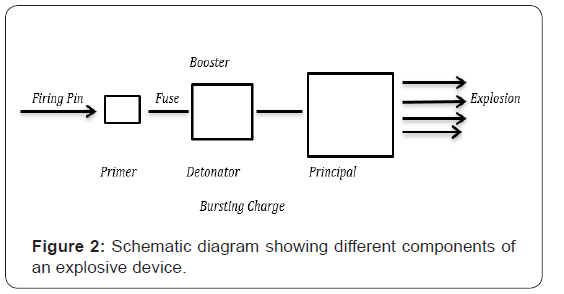
Result
Autopsy findings
Deceased-1: A 50 year old male adult of good built, length 152 cm and weight 85 Kgs was brought to the mortuary of the Department of Forensic Medicine, IMS BHU, Varanasi (India) on 29/08/2018 at 7.30 PM for medicolegal post-mortem examination. His eyes were closed, tongue was protruding and mouth was partially open. Nasal bleeding from external nasal orifices was present indicating fracture of base of skull (anterior cranial fossa). Post-mortem hypostasis was fixed and did not blanch on pressure, rigor mortis was present all over the body and liquefied portion of brain matter was found spread over front and lateral aspect of the body trunk as a curdy material. White flakes and post-blast explosive particles (PBR) spread all over the body trunk and upper limbs were also noted. Punctate lacerations, dust tattooing and black soiling from explosive materials (Marshall’s triad) were also found over the posterior aspect of upper chest (on the mid part and some portion of it extended up to lateral side towards shoulder region). Ante-mortem Injuries i) Multiple abrasions due to blast-effect were present 2 cm below the tip of left shoulder on front side of size 5cm X 6 cm. ii) Blast-effect on back side of the head was seen which lead to missing of most of the cranial bones and soft tissues. Few skull bones were present in fragmented condition. On Internal examination: iii) Brain matter was seen in liquefied form admixed with small fragments of cranial bones. On opening the chest wall and pleural cavity, rupture of upper lobe of both the lungs (blast lung) was seen. Rest of the viscera was normal as this was a case of instantaneous death. • Cause of death: Instantaneous death due to blast effect on back of the head.
Deceased-2: A 19-year-old male adult of average built and nutrition, with body length 156 cm and weight 67 Kgs. Postmortem hypostasis was fixed and did not blanch on pressure (indicating PMI > 8 Hrs), rigor mortis was present all over the body (indicating PMI > 12 Hrs). The adjoining area of blast effect showed peppering with blast triad. It was also noted that white flakes and post-blast explosive particles (PBR) were spread over the upper part of body trunk and both the upper limbs. Post-blast explosive materials were collected by cotton swab from all over the body. Ante-mortem Injuries i) Blast-effect on back of skull, back and front of neck, tip of left shoulder and upper part of back side of chest. It was bone deep. Back of skull, all cervical bones, tip of left upper portion of scapula were missing. ii) Skin and soft tissue of upper part of adjoining chest and neck area, scalp and posterior aspect of the shoulder region were missing. There was blackening and charring of the adjoining area. iii) Crater formation over left scapular region and tip of left shoulder. iv) Brain was missing as it was blown away.
Internal examination
Most of the brain matter was missing and a few left-over brain matter was seen in liquefied form admixed with small fragments of cranial bones. On opening the chest wall and pleural cavity, rupture of upper lobe of both the lungs (blast lung) was seen. Rest of the viscera was normal as this too was a case of instantaneous death. • Cause of death: Instantaneous death due to blast effect on head, neck and upper part of back of chest. No other injury noted over lower trunk and extremities in both the cases is suggestive of unidirectional and positioned nature of explosion.
Explosive findings
The post blast residue samples from different places of the bodies of the two victims were collected along with samples of burnt clothes were also collected and analysed by us in the presence of technical support of SEM-EDS unit in Department of Chemical Engineering of Indian Institute of Technology, B.H.U., Varanasi for analysis of post blast residues of explosive material used in this particular bomb blast. The post blast residue particles collected from the scene of crime and from the body during postmortem examination as well as clothes of the victims, showed white crystalline powder which was soluble in water, were detected. The 86% of the particle’s diameter was 30-50μ. These particles were smooth surfaced, spheroidal particles (72% of the particles between 100- 120μ in diameter on an average) found at closest sample distance of 1 m from AlAN (Aluminised ammonium nitrate) detonations. Initially the analysis of post blast residues began with a number of calorimetric screening tests and TLC using silica plate with the solvent being acetone as discussed earlier in material and method
These particles were hollow, cracked particles, suggestive of residual explosives being vaporised or molten as it moved through the air, and surface tension and drag effect on the fluid acted which has hardened the exterior surface of the particle. Prior to subjecting the aluminium nitrate particles for SEM-EDS analysis, the AN particles were mainly solid and dense. The spheroidal post blast particles found at 1 m distance were hollow with porous shells, the liquid explosive may have air pockets during flight, essentially forming bubbles of minimum surface area with cold and solidified into such hollow spheres. When these post blast residues were subjected to SEM-EDS test to find particles with elemental composition to be consistent with that of the explosive, specifically consisting of only N, O, Al, Ca, Si, Fe, Zn, Mn and Pb in few samples (of the cloth and swab) and C (the presence of carbon being ubiquitous in most particles).
Most of the common explosives have Nitrogen as a component of the molecule, hence was the presence of the elemental Nitrogen in most of our analysed samples and suffices its presence. Nitrogen confers instability to the explosive substance. The decomposition of the explosive molecules provides sufficient gas (Nitrogen) and heat to give the explosive effect. The main use of ammonium nitrate is as a fertilizer; however, it is an important component of many explosive formulations, especially in industrial explosives such as, dynamites as well as ANFO (ammonium nitrate + fuel oil), ANFO-Al (ammonium nitrate + fuel oil + Al) and various other forms of industrial explosives. Ammonium nitrate is highly stable. It has low sensitivity to friction and impact. It is an explosive of choice for industrial purposes as well as explosive of choice in most of the IEDs. It is a good oxidizer (hence high oxygen content is detected by SEM-EDS in our samples). The fuel oil used for combustion of the explosive is either hydrocarbon fuel in forms such as diesel or solid fuels aluminium sugar and sulphur. The elemental aluminium is detected in the sample is due to the use of aluminium in combustion fuel as an essential component of ANFO-Al.
Aluminium is used as an energy source as well as a stabilising agent in ANFO. The second highest (atomic %wise) presence of silica is due to the silica gel used as coating material of the TLC plate, used as an initial test for exclusion of post blast residue samples. The acetone is used as a solvent in TLC test. Images E1 - E3 are SEM images of ammonium nitrate powder (in the form of flakes) which is white crystalline powder, hygroscopic in nature found at different distances from the detonation sites. C1-C3 SEM micrograph of AN prills (Orica Prills) detected from the cloth samples found at different distances from the detonation sites obtained in our analysis.
Spectra E1-E3 are EDX spectrum of one of the small flakes of ammonium nitrate pellets (Orica Prills) of post blast residues collected from elbow area of the deceased. Spectra C1- C3 are EDX spectrum of the small particles of post blast AN residue from the cloth samples obtained in our analysis. Tables 1-6 are showing atomic percentage of elements detected by SEM-EDS of samples collected from different body parts and cloth samples.
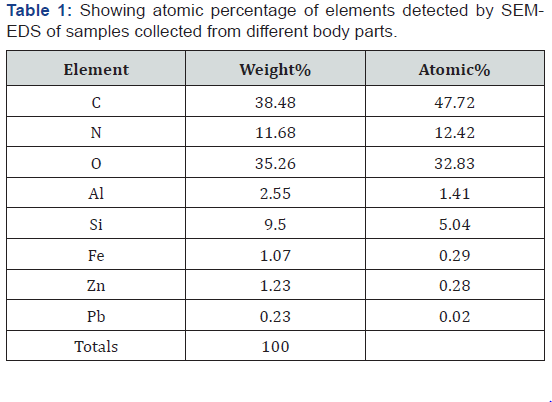
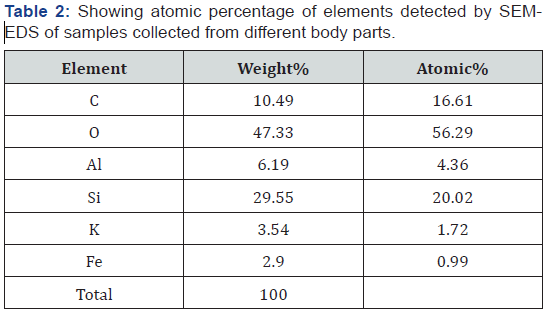
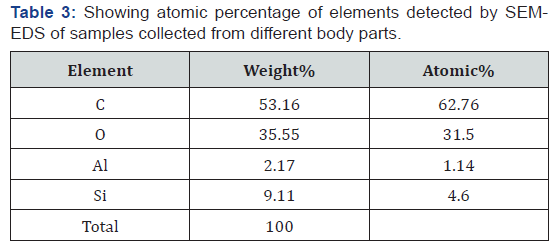
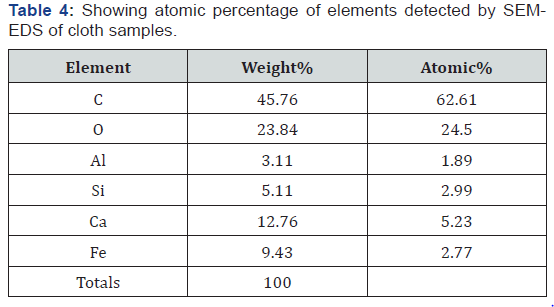
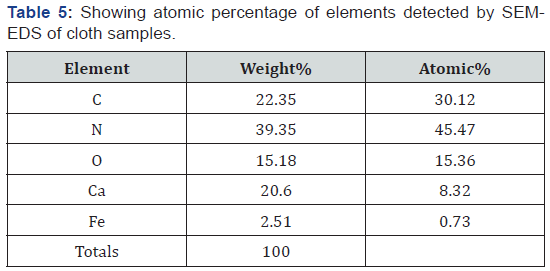
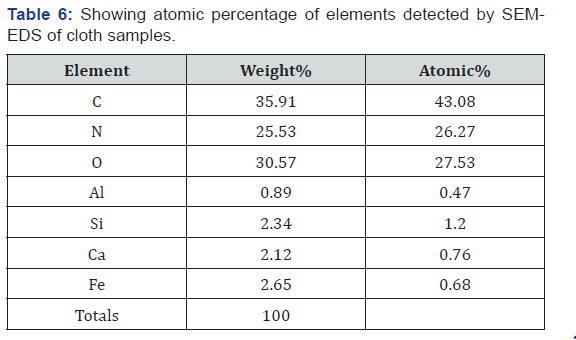
Remark- The explosive used in the present case belongs to industrial group of explosives which was ANFOAL (AN + Fuel Oil + Aluminium) along with the use of gun cotton which is Nitrocellulose containing Nitrogen beyond 15% to make the explosive mixture smokeless. The Nitrocellulose along with the used carbonaceous fuel (diesel) were also responsible for high concentration of carbon and nitrogen content detected by SEMEDS during chemical analysis of the explosive material used. The type of bomb which was planted was a variety of IED that is position bombs.
Discussion
According to Times of India, Lucknow edition, dated 30-08- 2018, a 48-year-old fodder trader and his 20-year –old son were killed in an improvised explosive device (IED) explosion. They were sleeping outside their shop in Milkipur village in Chaubeypur Police station area of Varanasi district, UP, India late on Tuesday 29-08-2018 at around 1 AM. SSP, Varanasi India had admitted that IED was used in killing the father son duo.
Discussion of ante-mortem injuries present on both the deceased
Deceased-1 I. Injury number: At autopsy the body may appear pigmented from this dust blasting, the clothing causing a shadow effect similar to bathing suit protection from sunburn. A more common appearance is a ‘peppering’ as a result of the numerous small missiles causing bruises, lacerations and abrasions [16]. A more common appearance is that of a sort of ‘peppering’ resulting from numerous small missiles/ fragments producing varying sized/designed abrasions, bruises and puncture lacerations of varying sizes and depth, intimately mixed on the skin. II. Injury number: If the victim is almost in contact with a large bomb, usually when he is carrying it or sitting with it in some vehicle, he may be blown to pieces. With smaller explosions or when the victim is a few feet away, disruption is limited to the blowing off of head or limb or the mangling of a localised area [15]. III. Injury number: Blast lung is the most common cause of death among people who initially survive an explosion. Considerable disruption at the alveolar capillary membrane (air-fluid interface) leads to capillary leakage, resulting in extensive haemorrhage in both lobes of lung. There is pulmonary contusion, systemic air embolism and free radical-associated injuries such as thrombosis and DIC, or a combination of all these-blast lung [5]. The magnitude of the blast varies with the energy released and also with the distance from the epicentre. As the distance from the explosion increases, the peak pressure falls rapidly, almost exponentially. About 100 lb/sq inch (690 kPa) is the minimum threshold for producing serious damage to human beings [15].
Deceased-2 i. Injury number Following an explosion, a person can be injured/ killed in a number of ways viz., if he is quite near to the explosion, he can be blown to pieces or he can be injured by a wave of pressure, called the ‘shock wave’, which spreads concentrically from the seat of the explosion. When the explosion is in air, the pressure wave is referred to as air blast [15]. There will also be pressure effects upon the viscera and these effects are far more damaging where there is an air–fluid interface, such as in the air passages, the lungs and the gut. Rupture and haemorrhage of these areas represent the classical blast lesion. A minimum pressure of about 700 kPa (100 lb/inch2) is needed for tissue damage in humans [17]. ii. Injury number Quaternary injuries include flash burns, crush injuries, fall resulting from the explosion, and respiratory injuries (toxic dust, gas) or radiation exposure [5]. Objects in the vicinity and the clothing may be ignited and the victim is then burnt by contact with the flame. These burns usually involve irregular areas of the skin to a different degree, and this feature differentiates them from the flash burns [15]. iii. Injury number Secondary injuries are due to people being injured by shrapnel and other objects propelled by the explosion. These injuries may affect any part of the body, and sometimes result in penetrating trauma [5]. iv. Injury number Many parts of the body may never be found having mixed with the masonry and other debris of the blast site because of disruptive effects of explosives [15]. v. Injury number In an explosion, the release of energy may be so great that death and disruption from blast effects occur over a wide area. A blast causes the most damage at an interface between tissues in contact with the atmosphere, which is why the lung usually suffers the most. There is controversy about whether pulmonary damage occurs from direct transmission of the shock wave through the thoracic wall, or through the oro-nasal orifices and air passages. In any event, the autopsy signs are of sub-pleural patchy haemorrhages, often in the line of the ribs, intrapulmonary haemorrhage and bullae at the lung margins [16].
Discussion on Explosive Findings

IED are devices which do not follow any specific pattern or design. An infinite variety of devices depending upon the skill in controlling of the culprit and materials are available. Such devices are generally made with malicious intentions to cause injury to life and property. IED essentially consists of a container, explosive material, a detonator and missiles. As explosive materials, the criminals often use nitrates of ammonia. The common active ingredients of the indigenous explosive devices are ammonium nitrate (a fertilizer), potassium chlorate etc. They are not only cheap but are also easily available. Besides, the assembling of Improvised explosive Devices (IEDs) does not involve high technical expertise. Normally most of the explosive substances contain nitrogen as an essential component. Nitrocellulose and the carbonaceous fuel used in ANFO are responsible for high carbon content in the explosive (Figure 3). Position bombs generally contain explosives filled in common containers such as tin, can, box etc. The current is provided from a battery filled in the container and the circuit is completed by mercury joining the contact points. The charge gets ignited, if the container is lifted from its position tilted or moved [3].
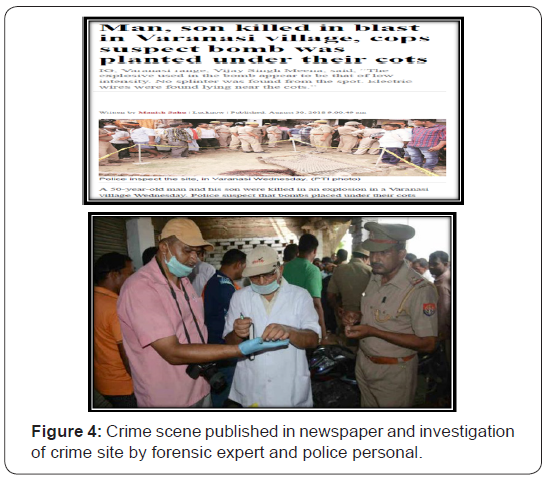
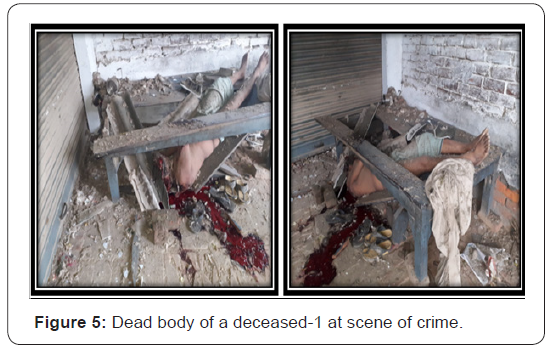
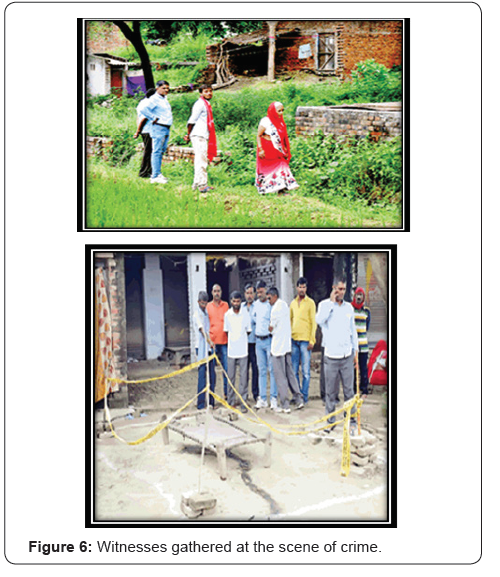
The explosives have been classified in ‘The Explosive Rules, 1983, Schedule I’ of India and according to this rule Nitrate mixtures are Class 2 group of explosives. According to sensitivitybased classification of explosives, ammonium nitrate is a secondary explosive as it requires a small charge of primary explosive as detonated to explode and also belongs to the industrial explosive group that is ANFO which consists of Ammonium Nitrate (94%) and fuel oil i.e. petroleum distillates (6%) being the most popular and widely used mixture. It is cheap, safe and easy to handle, yet powerful (Figures 4-6).
A number of formulations have come up for ANFO explosives [6]. With the exception of acid bombs found in plastic soda bottles, the types of explosives that are the most widely encountered improvised explosives in the United States are black powder, photoflash powder, and various other chlorate/perchlorate mixtures. Urea nitrate is a colourless to off-white crystalline product that is believed to have been used as the improvised explosive in the World Trade Centre bombing of 1993. There are no known commercial uses of urea nitrate. Possible clandestine manufacture of urea nitrate is indicated by the presence of Urea, fertilizer, Urine, Strong acids, Nitrate salts (potassium nitrate, sodium nitrate, and AN) of at a site. The presence of the wellventilated area, Glassware, Mixers, Filters, Ice, Safety equipment, including glasses, gloves, and dust masks also may signify clandestine manufacture of urea nitrate in the area
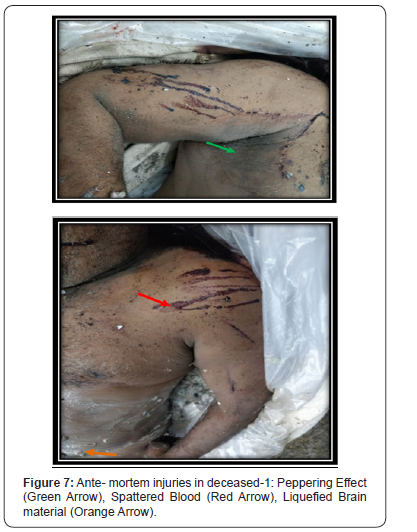
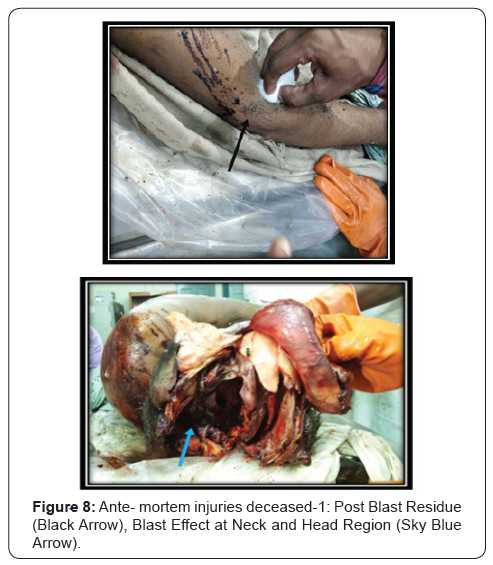

Indications of the preparation of urea nitrate further include the presence of acid caused discolorations or staining of the area (walls, ceilings, and floor) surrounding the site used to produce the explosive. Ammonium nitrate is good oxidizer and is highly hygroscopic. It can alone explode, if heated in airtight containers at 200 C [6]. Ammonium nitrate prills could be coated with a low percentage of a non-reactive material, a coal combustion by-product (CCB; fly ash or gypsum), to prevent the ANFO from detonating [12]. Identification features for AN-based explosives may include their unique odour of diesel or fuel oil or some other hydrocarbon fuel, along with their appearance, which include the following colour and structures owing to the easy availability of fuels: silver or grey powder or pills, white to off-white pills, and pink to reddish pills (Figure 7-9).
The chemical components of AN-based explosives are ANfertilizer, Solid fuels (aluminium, sugar and sulphur), Liquid fuels such as diesel fuel. The presence of the Grinders and blenders, Safety equipment, including glasses, gloves, and dust masks equipment may signify clandestine manufacture of AN in the area. The elemental aluminium found during chemical analysis by SEM-EDS test in the explosive mixture was due to aluminium powder used in the IED. This photoflash colour of the black gun powder is the result of one of the ingredients in the powder i.e. aluminium powder. Improvised photoflash powder may exhibit small granules of a white substance, which is covered with the aluminium powder [12]. In our chemical analysis conducted on post blast residues samples using SEM-EDX using NSS software derived the atomic percentages of different elements present in the clothes PBR showed the second highest atomic percentage of presence of silicon.

In another study conducted by Bob Hafner, Energy Dispersive spectroscopy on the SEM: A Primer, showed similar result that is the proportions of the elements relative to Silicon-most abundant. One might expect the relative proportions for both data types to align with one another- i.e., there should be a close parallel between number of counts and atomic percentage [9]. Additional support for this is that the internal structures of the undetonated AN particle and those post blast particles found at 2 m and 3 m were similarly dense throughout rather than hollow. Larger clusters (up to 1000μm in diameter), moving away from the bulk charge surface with greater kinetic energy, may have impacted onto the surfaces at high velocity to deposit as particle mounds surrounded by flattened surrounding edges (Figure 10).
While the number of observed particles decreased with increasing distance from the detonation, without density information, attempts to quantify the mass of explosive residue on each stub based only on particle counting was impossible. Such a trend is comparable with previous studies that have also found the amount of AN to decrease accordingly with increasing distance from a detonation. Without being able to distinguish between ammonium/nitrate contributions from the explosive and that potentially from any deposited sediment, these quantifications are suggestive at best and cannot be associated accurately to the particle number observed on each stub. Aluminised ammonium nitrate particles remain in same physical state or composition even prior to detonation and after detonation as a post blast residue [7]. According to Firearms in Criminal investigation and trial authored by B R Sharma, the volume of the products of explosion is many times the volume of the explosive used [6]. In order to exclude the presence of RDX in our post blast samples, the following morphological pre- and post-detonation particle shape and size and its distance at which it was present in postblast samples in SEM-EDS test and also its distinction in these parameters apart from other parameters for identification of AlAN were considered while literature support from different authors on post blast residue study conducted worldwide(Figure 11).
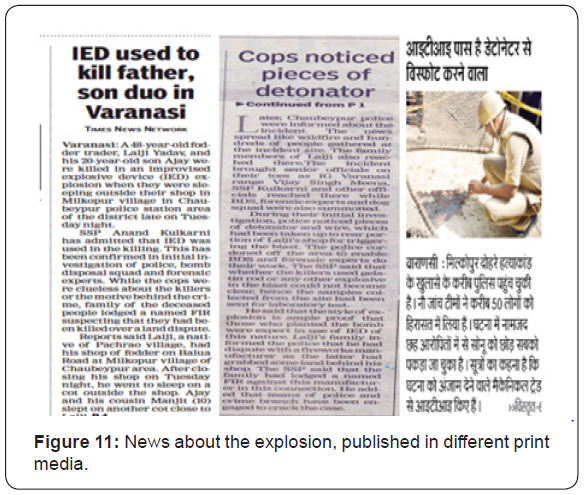
According to Crime Scene Management- a Forensic Approach authored by Dr MS Rao and BP Maithil [3, RDX looks like off white pliable plastic [3]. In another study conducted by Banas A et al. [2] Post-blast detection of traces of explosives by means of Fourier transform infrared spectroscopy, C-4 (composition C-4) is a plastic explosive in which the explosive agent is RDX. Trade names of RDX are Cyclonite or Hexogen [2]. A major advantage of C-4 is that it can be moulded into any desired shape. RDX is a white crystalline powder that is found in a large number of military explosive compositions and is considered to be one of the most stable and powerful high explosives [2]. The stable form of RDX at room temperature (α-RDX) has an orthorhombic crystal structure. When amassed within a plasticizer matrix to form a plastic explosive (PE) composition, discernible particles have a diameter of between approximately 10 μm to 500 μm and are therefore smaller than the pre-blast AlAN particles. Unlike the post-blast AlAN results, no spheroidal PE4 particles were found at 1 m from the detonations.
The internal structures of post-blast PE4 also varied to that of AlAN found at 1 m, which were hollow, and furthermore were different to that of the pre-blasted PE4 form, which were predominantly dense within. The post-blast particles observed after firings were grouped into distance ‘bins’ of 1 m, ‘2 m and 3 m’, and ‘4 m and 5 m’ from the detonations. No particles, of any type, were seen on stubs retrieved further than 5 m from the detonations. The majority of post-blast PE4 residue particles at the closest sampled distance of 1 m from the detonations had smooth edged, folded and curved shapes (66 % of which were 10μm to 100μm in diameter; none resembled their undetonated form. The decomposition of RDX includes the rapid production of N2 and H2O within pico-seconds, followed by the delayed production of CO molecules beyond nanosecond time scales.
SEM-EDS findings in our case
Images E1 - E3 Figure 12 are SEM images of ammonium nitrate powder (in the form of flakes) which is white crystalline powder, hygroscopic in nature found at different distances from the detonation sites. C1-C3 SEM micrograph of AN prills (Orica Prills) detected from the cloth samples found at different distances from the detonation sites obtained in our analysis. Figure 13 Spectra E1 - E3 are EDX spectrum of one of the small flakes of ammonium nitrate pellets (Orica Prills) of post blast residues collected from elbow area of the deceased. Spectra C1- C3 are EDX spectrum of the small particles of post blast AN residue from the cloth samples obtained in our analysis. Tables 1-6 are showing atomic percentage of elements detected by SEMEDS of samples collected from different body parts and cloth samples. N.B., How-so-ever control images of AN prill (Figure 14), RDX & PE4 (Figure 15), EDX spectra of AN perils (Westland) and different photographs of various sizes of AN prills were used as standard references to compare, cross-verify and validate our study (Figures 16 &17). No published literature till date has reported the particle size ranges and characteristic morphological differences of post blast explosive residue reported herein. The majority of explosive particles were found to be larger than postblast pyrotechnic residues identified from previous studies. The ability to discriminate between the explosive charges fired based solely on the remaining residues has invaluable potential at post-blast crime scenes where the rapid nature of investigations requires fast results [7]. The fabrication of improvised primary and secondary explosives may, for some, bring to mind the stereotype of the “mad bomber” tucked away in his or her dank laboratory, preparing the “witches’ brew” [12].


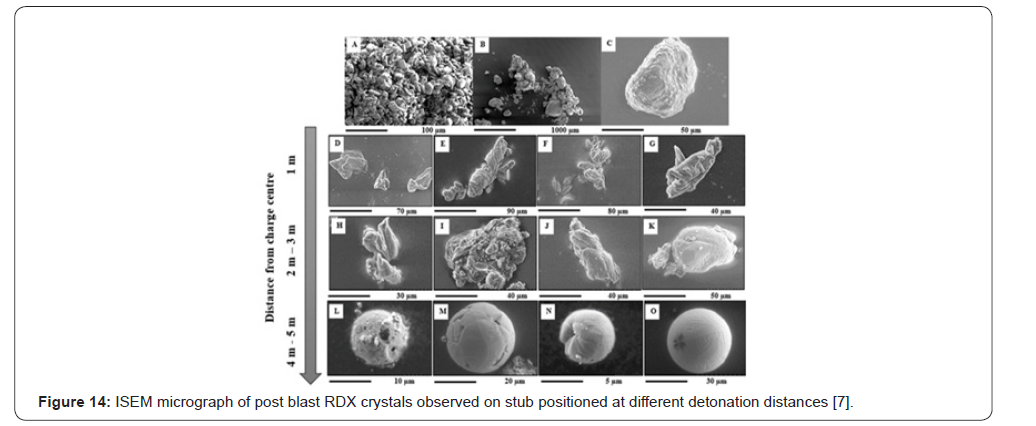
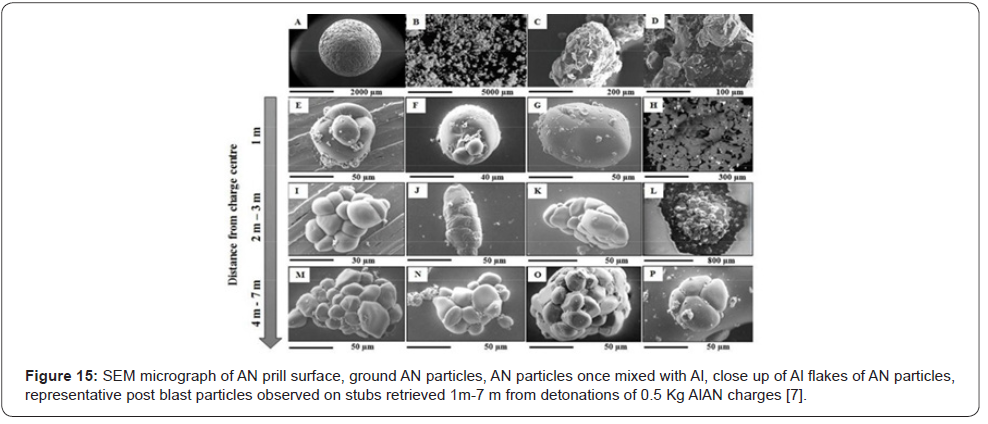
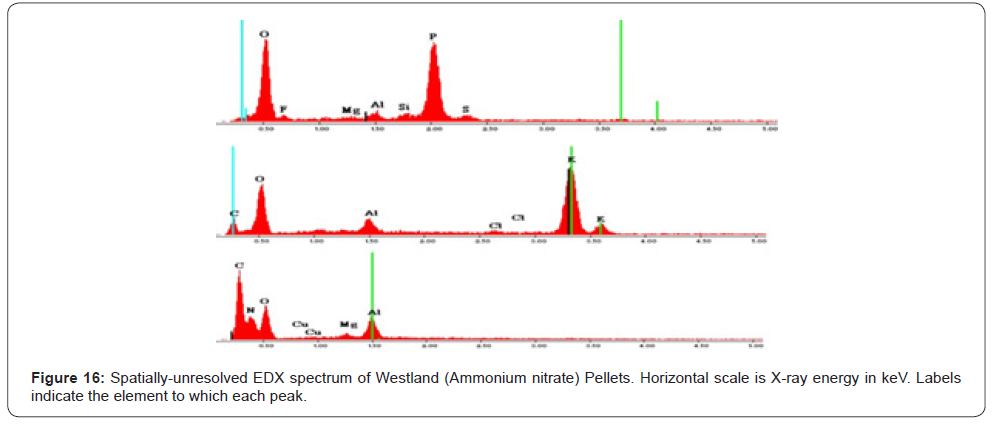
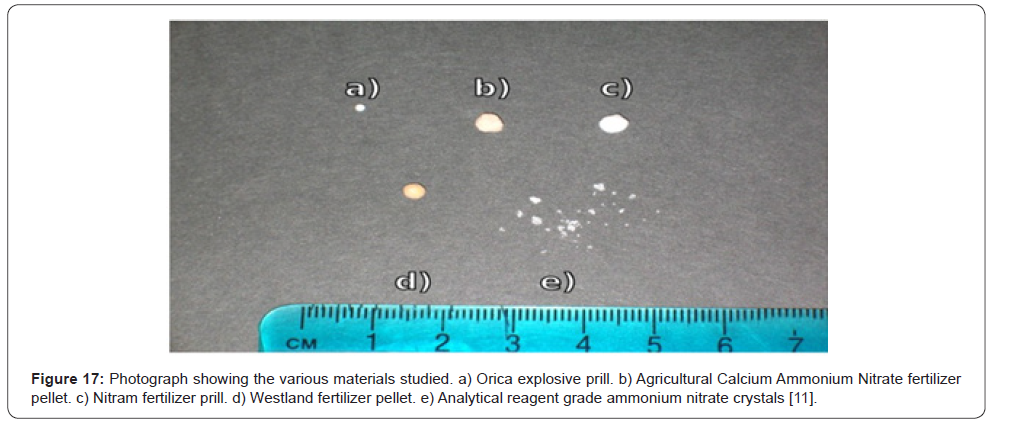
Conclusion
The post-mortem examination is critical to the investigation of explosives related deaths for all these purposes. Last year, there was a 26 % increase in IED blast incidents vis-à-vis 2015 and casualties have increased by 3 % vis-à-vis 2015, according to NBDC. The ability to discriminate between the explosive charges fired based solely on the remaining residues has invaluable potential at post-blast crime scenes where the rapid nature of investigations requires fast results. Such an evidence base provides an essential first step for enabling forensically relevant interpretations of particulates in crime reconstructions; the importance of which for offering robust, reliable intelligence and evidence pertaining to the type of explosive used in terrorism cases is highly significant. The complexity associated with postblast explosive analysis necessitates not only the development of existing standard analysis techniques, but the application of more unconventional methods in order to probe further into discoveries about the nature of these materials.
If any person is found to have in his possession or under his control any explosive under such circumstances as to give rise to a reasonable suspicion, the court of a regional division has power to impose certain penalties under the explosive act 1884, amended in 1978. Any person who contravenes any provision of section 7, 8 or 9 shall be guilty of an offence and liable on conviction to a fine or to imprisonment for a period not exceeding two years. [Sec 10 amended by sec 5 of Act 21 of 1963 and substituted by sec 6 of Act 5 of 1981 and by sec 5 of Act 178 of 1993.]
Acknowledgement
We are sincerely thankful to all the technical and supporting staff of Department of Forensic Medicine, I.M.S., B.H.U., Varanasi (INDIA) and Department of Chemical Engineering, I.I.T., B.H.U., Varanasi (INDIA) for providing all the necessary help as and when needed.
References
- Newton DE (2007) Forensic Chemistry. Facts on File (An imprint of Infobase Publishing) Pp. 128.
- Banasa A, Banasa K, Bahoua M, Moserab HO, Wena L, et al. (2009) Post-blast detection of traces of explosives by means of Fourier transform infrared spectroscopy. Vibrational Spectroscopy 51(2): 168-176.
- Rao MS, Maithil BP (2013) Explosion Cases: Crime Scene Management-a Forensic Approach. Selective & Scientific Books, (2nd edn), PP: 248-260.
- Shaurya Karanbir Gurung (2018) Believe it or not: India had the highest number of blasts in the world.
- Biswas G (2019) Explosion Injuries and Fall from Height: Review of Forensic Medicine & Toxicology. (4th edn), Jaypee Brothers Medical Publishers (P) Ltd, New Delhi, India: PP. 296-299.
- Sharma BR (2017) Explosives and Explosions: Firearms in Criminal Investigations and Trials an Integrative Approach. (5th edn) Lexis Nexis (A division of Relx India Pvt Ltd), Gurugram, Haryana, India PP: 480-499.
- Nadia Abdul Karim et al. Morphological Variations of Explosive Residue Particles and Implications for Understanding Detonation Mechanisms. ACS Paragon Plus Environment.
- D Souza Marvin, Kataria RP (2016) Forensic explosives: Forensic science in criminal trial & investigations. Orient Publishing Company (1st Edn) PP: 1364-1365.
- Bob Hafner. Energy Dispersive spectroscopy on the SEM: A Primer.
- Jay Siegel, Geoffrey Knupfer (2000) Encyclopaedia of Forensic Sciences (2nd Edn) Pekka Sukko Elsevier Science &Technology, USA.
- Nicholas Taylor (2011) Hot spots in Ammonium Nitrate. Department of Physics, Dissertation for the degree of Doctor of Philosophy, Churchill College, University of Cambridge, England PP. 85-100.
- James T, Thurman (2017) Identification and Recognition of Commercial, Improvised, and Military Explosives: Practical Bomb Scene Investigation (3rd Edn); CRC Press, USA PP: 82-85.
- Di Maio VJM (2016) Detection of Gunshot Residues: Gunshot wounds. (3rd edn); CRC Press Pp. 292-294.
- Kobilinsky L (2012) Principles and Issues in Forensic Analysis of Explosives: Forensic Chemistry Handbook, John Wiley & Sons, Inc, Hoboken (Eds.), New Jersey, USA, Pp: 29.
- Vij K (2011) Injuries by Explosives: Textbook of Forensic Medicine and Toxicology. (5th edn) Reed Elsevier India Private Limited PP. 266-269.
- Saukko P, Knight B (2016) Gunshot and explosion deaths: Knight’s Forensic Pathology. (4th edn); CRC Press (Taylor & Francis Group), USA, PP: 268-271.
- James JP, McGovern C, Jones R, Karch SB, Manlove J (2014) Ballistic and Explosive Injuries: Simpson’s Forensic Medicine. Irish Version, (13th edn); CRC Press (Taylor & Francis Group), USA PP: 134-135.






























